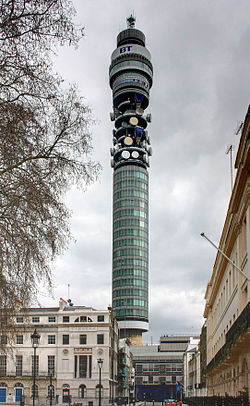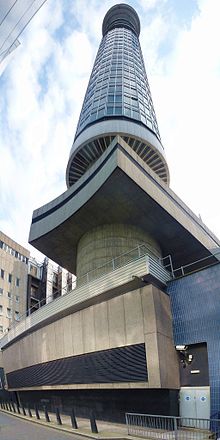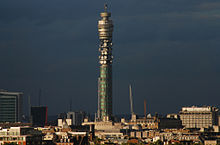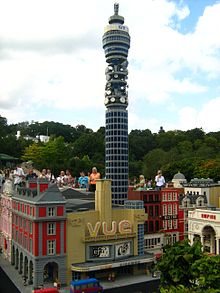
BT Tower
Did you know...
SOS Children offer a complete download of this selection for schools for use on schools intranets. A good way to help other children is by sponsoring a child
| BT Tower | |
|---|---|
 BT Tower from Conway Street Tallest building completed in London in the 1960s |
|
| General information | |
| Type | Offices |
| Location | London, United Kingdom |
| Coordinates | 51.5215°N 0.1389°W Coordinates: 51.5215°N 0.1389°W |
| Construction started | 1961 |
| Completed | 1964 |
| Height | |
| Antenna spire | 189.0 metres (620.1 ft) |
| Technical details | |
| Floor count | 37 |
| Lifts/elevators | 2 |
| Design and construction | |
| Architect | Eric Bedford |
The BT Tower is a communications tower located in Fitzrovia, London, owned by BT Group. It has been previously known as the Post Office Tower, the London Telecom Tower and the British Telecom Tower. The main structure is 177 metres (581 ft) tall, with a further section of aerial rigging bringing the total height to 189 metres (620 ft). It should not be confused with the BT Centre (the global headquarters of BT). Its Post Office code was YTOW.
In 1962, while still under construction, the BT Tower overtook St Paul's Cathedral to become the tallest building in London. Upon completion it overtook the Millbank Tower (which had been constructed faster) to once again become the tallest building in both London and the United Kingdom, titles it held until 1980, when it in turn was overtaken by the NatWest Tower.
History
20th century
The tower was commissioned by the General Post Office (GPO). Its primary purpose was to support the microwave aerials then used to carry telecommunications traffic from London to the rest of the country, as part of the British Telecom microwave network.
It replaced a much shorter steel lattice tower which had been built on the roof of the neighbouring Museum telephone exchange in the late 1940s to provide a television link between London and Birmingham. The taller structure was required to protect the radio links' "line of sight" against some of the tall buildings in London then in the planning stage. These links were routed via other GPO microwave stations at Harrow Weald, Bagshot, Kelvedon Hatch and Fairseat, and to places like the London Air Traffic Control Centre at West Drayton.
The tower was designed by the architects of the Ministry of Public Building and Works: the chief architects were Eric Bedford and G. R. Yeats. Typical for its time, the building is concrete clad in glass. The narrow cylindrical shape was chosen because of the requirements of the communications aerials: the building will shift no more than 25 centimetres (10 in) in wind speeds of up to 150 km/h (95 mph). Initially the first sixteen floors were for technical equipment and power, above that was a 35 metre section for the microwave aerials, and above that were six floors of suites, kitchens, technical equipment and finally a cantilevered steel lattice tower. To prevent heat build-up the glass cladding was of a special tint. The construction cost was £2.5 million.
Construction began in June 1961, and owing to the building's height and its having a tower crane jib across the top virtually throughout the whole construction period, it gradually became a very prominent landmark that could be seen from almost anywhere in London. In August 1963 there was even a question raised in Parliament about the crane. Doctor Reginald Bennett MP asked the Minister of Public Building and Works how, when the crane on the top of the new Post Office tower had fulfilled its purpose, he proposed to remove it. Mr Geoffrey Rippon replied, "This is a matter for the contractors. The problem does not have to be solved for about a year but there appears to be no danger of the crane having to be left in situ."
The tower was topped out on 15 July 1964 and officially opened by Prime Minister Harold Wilson on 8 October 1965. The Main Contractor was Peter Lind & Co Ltd.
The tower was originally designed to be just 111 metres (364 ft), and its foundations are sunk down through 53 metres of London clay and are formed of a concrete raft 27 metres square, a metre thick, reinforced with six layers of cables on top of which sits a reinforced concrete pyramid.
The tower was officially opened to the public on 16 May 1966 by Tony Benn and Billy Butlin. As well as the communications equipment and office space there were viewing galleries, a souvenir shop, and a rotating restaurant, the "Top of the Tower", on the 34th floor, operated by Butlins. It made one revolution every 22 minutes. An annual race up the stairs of the tower was established and the first race was won by UCL student Alan Green. Tony Benn also designated the tower a mascot of UCL after lobbying by students.
A bomb, responsibility for which was claimed by the Provisional IRA, exploded in the roof of the men's toilets at the Top of the Tower restaurant on 31 October 1971. The restaurant was closed to the public for security reasons in 1980, the year in which the Butlins' lease eventually expired. Public access to the building ceased in 1981. The Tower is sometimes used for corporate events, but the closure of the Tower restaurant to the public means London has no revolving restaurant of the type common in major cities throughout the world; although reports that the restaurant would re-open emerged in 2009.
Until the mid-1990s, the building was officially a secret, and did not appear on official maps. Its existence was finally "confirmed" by Kate Hoey, MP, on 19 February 1993: "Hon. Members have given examples of seemingly trivial information that remains officially secret. An example that has not been mentioned, but which is so trivial that it is worth mentioning, is the absence of the British Telecom tower from Ordnance Survey maps. I hope that I am covered by parliamentary privilege when I reveal that the British Telecom tower does exist and that its address is 60 Cleveland Street, London."
21st century
The tower is still in use, and is the site of a major UK communications hub. Microwave links have been replaced by subterranean fibre optic links for most mainstream purposes, but the former are still in use at the tower. The second floor of the base of the tower contains the TV Network Switching Centre which carries broadcasting traffic and relays signals between television broadcasters (including the BBC), production companies, advertisers, international satellite services and uplink companies. The outside broadcast control is located about the former revolving restaurant, with the kitchens on floor 35.
A renovation in the early 2000s introduced a 360-degree coloured lighting display at the top of the tower. Seven colours were programmed to vary constantly at night and intended to appear as a rotating globe to reflect BT's "connected world" corporate styling. The coloured lights give the tower a distinctive appearance on the London skyline at night. In October 2009, a 360-degree full-colour LED-based display system was installed at the top of the tower, to replace the previous colour projection system. The new display, referred to by BT as the "Information Band", is wrapped around the 36th and 37th floors of the tower, 167m up. The display comprises some 529,750 LEDs arranged in 177 vertical strips, spaced around the tower. The display is the largest in the world of its type, occupying an area of 280m2 and with a circumference of 59m. On 31 October 2009 the screen began displaying a countdown of the number of days until the start of the London Olympics in 2012.
In October 2009, The Times reported that the rotating restaurant would be reopened in time for the 2012 London Olympics. However, in December 2010, it was further announced that the plans to reopen had now been 'quietly dropped' with no explanation as to the decision.
The BT Tower was given Grade II listed building status in 2003. Several of the defunct antennas located on the building could not be removed unless the appropriate listed building consent was granted, as they were protected by this listing. In 2011 permission for the removal of the defunct antennas was approved on safety grounds as they were in a bad state of repair and the fixings were no longer secure. In December 2011 the last of the antennas was removed leaving the core of the tower visible.
Entry to the building is provided by two high-speed lifts which travel at 7 metres per second, reaching the top of the building in under 30 seconds. An Act of Parliament was passed to vary fire regulations, allowing the building to be evacuated by using the lifts - unlike other buildings of the time.
The tower is being used in a study to help monitor air quality in the capital. The aim is to measure pollutant levels above ground level to determine their source. One area of investigation is the long-range transport of fine particles from outside the city.
Appearances in fiction
- In Sky1's adaptation of The Runaway the IRA bombing of the tower is featured in episode 4.
- Large portions of the 1966 Doctor Who serial The War Machines were set in and around the tower. It is also mentioned in the 1968 serial The Web of Fear and the spin-off Sarah Jane Adventures serial The Mad Woman in the Attic.
- In the 1967 film Smashing Time it appeared to spin out of control and short-circuit the whole of London's power supply.
- The tower is featured in Stanley Donen's 1967 film Bedazzled as a vantage point from which Peter Cook, playing Satan, launches various forms of mischief.
- The tower is featured in the most famous scene in The Goodies when it is toppled over by Twinkle the Giant Kitten in the episode Kitten Kong. This scene was included in the title sequence of all later series.
- A later episode of The Goodies, Alternative Roots, includes a brief, chaotic visit to the tower's revolving restaurant.
- The tower is destroyed by an alien robot from Mars in an episode of Danger Mouse.
- In Alan Moore's graphic novel V for Vendetta the tower is headquarters for both the "Eye", and the "Ear", the visual and audio surveillance divisions of the government. The tower is destroyed through sabotage. It is also featured in the film adaptation although it is not destroyed. It is renamed Jordan Tower in the film and is the headquarters of the "British Television Network".
- The tower is destroyed in the James Herbert novel The Fog by a Boeing 747 whose captain has been driven mad by fog. Domain, another James Herbert novel, mentions the tower's destruction when London is attacked by nuclear weapons.
- In The New Avengers (TV Series) episode Sleeper, the heroes Steed and Gambit view the deserted city from the 34th floor of the Tower - at the time, photography and filming were not permitted in the Tower due to it being covered by the Official Secrets Act.
- The tower appears abandoned and covered in pleurococcus in a BBC TV adaptation of The Day of the Triffids.
- The design of the starship HMS Camden Lock from the BBC 2 science fiction sitcom Hyperdrive is based on the tower.
- In Harry Potter and the Chamber of Secrets, Harry is spotted flying over the tower in a Ford Anglia with his friend, Ron Weasley.
- It appears on the cover of, and features in, Saturday by Ian McEwan.
- Frank Muir's short story The Law Is Not Concerned With Trifles is set in the tower's revolving restaurant.
- Rowan Atkinson in Not the Nine O'Clock News plays a Frenchman who claims that the Post Office Tower was not a communications tower but a London phallus.
- In The Bourne Ultimatum movie, there is a helicopter's view shot of the tower building for a brief period of time to show the location.
- In Season 4 of ReBoot, a tower closely resembling the BT tower is seen in the first episode as a control tower being able to open the system of Mainframe to the net.
- In Patrick Keiller's film London (1992) the narrator claims the tower is a monument to the love affair between Arthur Rimbaud and Paul Verlaine, who lived nearby.
- The bombing is a central plot feature of Hari Kunzru's 2007 novel My Revolutions, in which the bomb is the work of political radicals who are never caught.
- In Daniel H. Wilson's 2011 novel, Robopocalypse the tower is used by the sentient artificial intelligence named Archos to control and jam satellite communications. It is destroyed by a hacker known as Lurker to help win the human/computer war.
- In the book Spiral by Roderick Gordans and Brian Williams, the BT Tower is entered for some kind search using microwaves, to detect Darklight activity by Drake.



